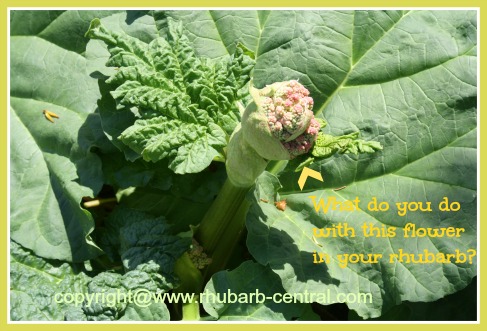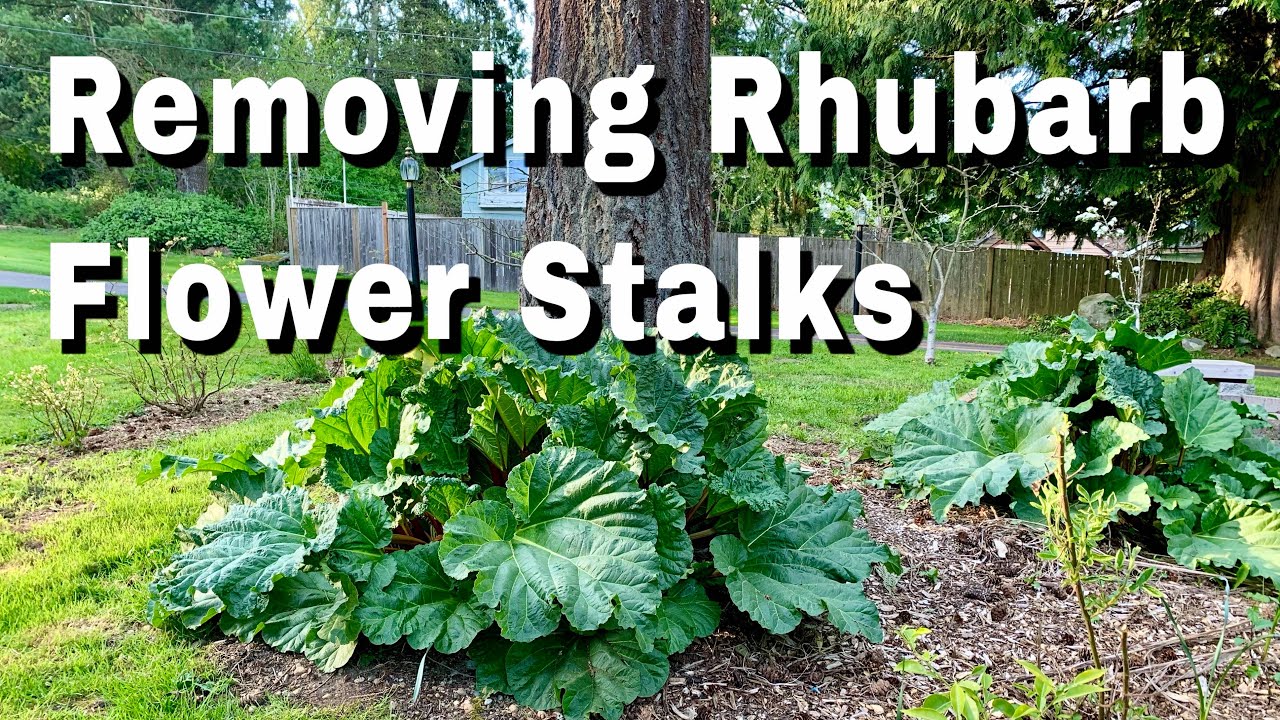To remove a rhubarb flower stalk, cut it close to the base of the plant. Rhubarb plants often send up flower stalks, and while the flowers themselves are attractive, they can signal a decline in the plant’s health and productivity.
To prevent the rhubarb from going to seed and redirect its energy back into leaf and stalk production, it is important to remove the flower stalks promptly. Removing the stalks is a simple process that involves cutting them close to the base of the plant.
By removing the flower stalks, you can ensure that your rhubarb plant continues to produce delicious and tender stalks for use in pies, jams, and other culinary delights

Credit: www.rhubarb-central.com
Why Removing Rhubarb Flower Stalks Is Important
Removing the flower stalks from your rhubarb plants is crucial for several reasons. Firstly, it helps prevent the loss of flavor and energy in the plant. Rhubarb flowers consume vital nutrients and energy that could be directed towards the growth of delicious stalks. By removing these flower stalks, you ensure that all the plant’s resources are focused on producing robust and flavorful rhubarb.
Additionally, removing flower stalks encourages the growth of larger rhubarb stalks. When the plant is allowed to flower, it diverts its energy towards producing flowers and seeds instead of concentrating on stalk growth. By removing the flower stalks, you signal to the plant to invest its energy in the development of sturdy and juicy rhubarb stalks.
Make it a regular habit to remove rhubarb flower stalks as soon as they appear to maximize the quality and quantity of your harvest. Your rhubarb plants will reward you with delicious and vibrant stalks capable of elevating your culinary creations.
Signs That You Need To Remove Rhubarb Flower Stalks
To maintain a healthy rhubarb plant and ensure a bountiful harvest, it is crucial to identify and remove rhubarb flower stalks at the right time. One telltale sign that you need to take action is the appearance of seed heads. These tall, slender stalks often bear small yellow or greenish-white flowers, signaling the plant’s transition into reproductive mode. While they may be aesthetically pleasing, allowing the rhubarb to flower can have a negative impact on future harvests.
When left to produce flowers, rhubarb expends energy that could be used for growth and leaf production instead. This can result in weakened stalks and decreased yields. Additionally, the plants may divert resources from the edible, fleshy stems to nourish the flowers and seed production, further diminishing the quality of the crop.
When To Remove Rhubarb Flower Stalks
To successfully remove the rhubarb flower stalk, it is essential to understand the optimal timing for its removal. The timing depends on the stage of growth of the plant. Ideally, it is best to remove the flower stalks as soon as they appear. This is because allowing the flower stalks to grow and bloom can drain valuable energy from the plant, affecting the overall yield of rhubarb.
By removing the flower stalks promptly, you can redirect the plant’s energy towards producing more robust and flavorful stalks. This is especially important if you intend to harvest the rhubarb for culinary purposes.
Regular inspection of the rhubarb plant is crucial to identify the early signs of flower stalk development. Look for the emergence of a tall and slender stem with small buds or flowers at the top. As soon as you spot these signs, grab a pair of sharp gardening shears or scissors and carefully cut the flower stalks at the base, as close to the crown as possible.
Remember, removing the rhubarb flower stalks at the right time can help maximize your rhubarb harvest and promote healthy plant growth.
Tools And Materials You’ll Need
When removing rhubarb flower stalks, it’s important to have the right tools and materials at hand. Here are the essentials:
Pruning Shears
Pruning shears or garden scissors are necessary for cutting off the rhubarb flower stalks. Make sure they are sharp and clean to ensure a clean cut and minimize damage to the plant.
Gloves
Wearing gloves is highly recommended when handling rhubarb plants. Not only do gloves protect your hands from thorns and prickles, but they also prevent any potential skin irritation that may occur when in contact with the plant’s sap.
Container For Collecting Stalks
A container is needed to collect the rhubarb flower stalks once they have been removed. This can be a basket, a bucket, or any other suitable container that allows you to easily transport the stalks without crushing or damaging them.
How to Remove Rhubarb Flower Stalk: Step by Step Guide
Step 1: Preparing For Rhubarb Flower Stalk Removal
Choosing the right time of day is essential when removing rhubarb flower stalks. It is best to do this task early in the morning or late in the evening when the plant is well-hydrated. This ensures that the stalks are more pliable and easier to remove without causing damage.
Ensuring proper sanitation of tools is crucial to prevent the spread of diseases or pests. Start by wiping down your tools with a cloth soaked in rubbing alcohol or a bleach solution. This helps kill any potential pathogens that can harm the plant.
Once the tools are sanitized, you can proceed with removing the rhubarb flower stalks. Grasp the stalk firmly near its base and gently twist it until it breaks off from the plant. Avoid pulling the stalk forcefully, as this may harm the rhubarb plant.
Step 2: Identifying And Locating Flower Stalks
When it comes to removing the flower stalk from rhubarb plants, it is important to first identify and locate the stalks. Flower stalks can be easily differentiated from the edible rhubarb stalks by their appearance. Flower stalks are tall, thin, and usually have flowers growing on top. On the other hand, the edible rhubarb stalks are thicker, shorter, and do not have flowers.
To locate the flower stalks that need to be removed, carefully examine the plant for any stalks that match the description of flower stalks. These stalks should be cut off at the base using a sharp pair of garden scissors or pruners. Dispose of the flower stalks properly to prevent any chance of reseeding. By following these steps, you can effectively remove the flower stalk from your rhubarb plant and promote the growth of more edible stalks.
Step 3: Removing Rhubarb Flower Stalks
To remove rhubarb flower stalks, start by cutting the stalk near the base to prevent regrowth. Cut as close to the plant as possible to remove the entire stalk. It’s important to discard the removed stalks in a proper manner. Rhubarb flower stalks should not be composted as they can harbor pests or diseases.
Instead, dispose of them in the trash or burn them if allowed in your area. Removing and discarding the flower stalks from your rhubarb plants will help redirect the plant’s energy back into producing delicious and tender stalks for consumption. Remember to cut the stalks near the base and dispose of them properly to ensure the health and productivity of your rhubarb plants.
Step 4: Post-removal Care For Rhubarb Plants
To ensure the future growth and health of your rhubarb plants after removing the flower stalk, it is important to provide proper care. This includes regular watering and fertilizing. Water your rhubarb plants deeply, ensuring that the soil is moist but not waterlogged. This will help the plants establish strong roots and promote new foliage growth.
Additionally, it is recommended to fertilize your rhubarb plants after stalk removal. Use a balanced organic fertilizer or compost to provide essential nutrients to the plants. Apply the fertilizer or compost around the base of the plants and gently work it into the soil.
To maximize the growth and production of your rhubarb plants, continue with regular watering and fertilizing throughout the growing season. This will ensure that your plants have the necessary nutrients to thrive and produce a bountiful harvest of delicious rhubarb.
Tips And Precautions For Removing Rhubarb Flower Stalks
To remove rhubarb flower stalks, it is important to take certain tips and precautions to ensure that the process is done correctly. First and foremost, wearing protective gloves is crucial to avoid any potential skin irritation. Rhubarb leaves contain oxalates, which can cause dermatitis in sensitive individuals.
Secondly, it is important to avoid damaging healthy stalks while removing the flower stalk. Gently hold the flower stalk near the base and pull it upwards to detach it from the plant. If the stalk doesn’t easily come off, use a sharp knife or shears to cut it close to the base. By following these tips and precautions, you can effectively remove rhubarb flower stalks without causing harm to the plant or yourself.
Frequently Asked Questions For How To Remove Rhubarb Flower Stalk
When Should You Not Pick Rhubarb?
Avoid picking rhubarb during the winter months, as it is in its dormant phase. Also, do not pick rhubarb when the stalks are small and thin, as they need time to grow. Additionally, refrain from picking rhubarb that is damaged or discolored, as it may not be safe to consume.
How Many Stalks Should I Leave On My Rhubarb Plant?
Leave at least 2 to 3 stalks on your rhubarb plant.
Can You Plant Rhubarb From A Stalk?
Yes, you can plant rhubarb from a stalk. Simply cut a piece of the stalk with a bud, and plant it in well-drained soil. Ensure it gets enough sunlight and water regularly.
How Do You Manage Rhubarb Plants?
To manage rhubarb plants, prune any dead or damaged stalks, and remove any weeds around the plant. Apply compost or well-rotted manure in spring to nourish the soil. Water regularly to maintain moisture, especially during dry periods. Harvest stalks by twisting and pulling, but avoid harvesting the first year after planting.
Conclusion
Removing rhubarb flower stalks is an essential task for ensuring a bountiful harvest. By following the simple steps outlined in this guide, you can effectively remove these stalks and divert the plant’s energy towards producing juicy and delicious rhubarb stems.
Remember to remove the flower stalks promptly to prevent the plant from going to seed. With a little care and attention, you’ll be enjoying rhubarb treats in no time. Happy gardening!

